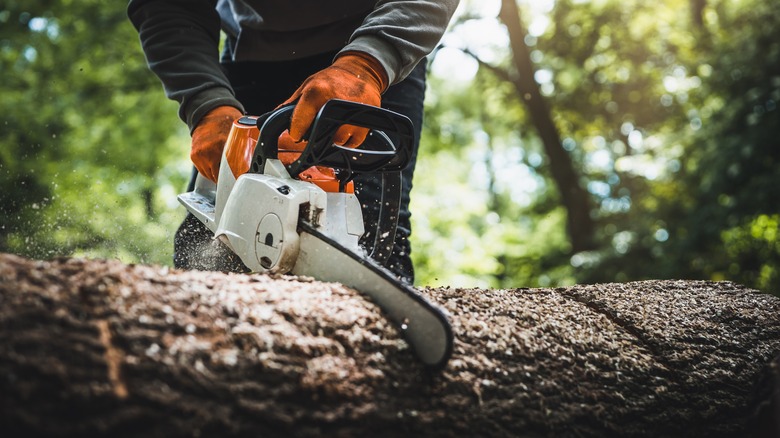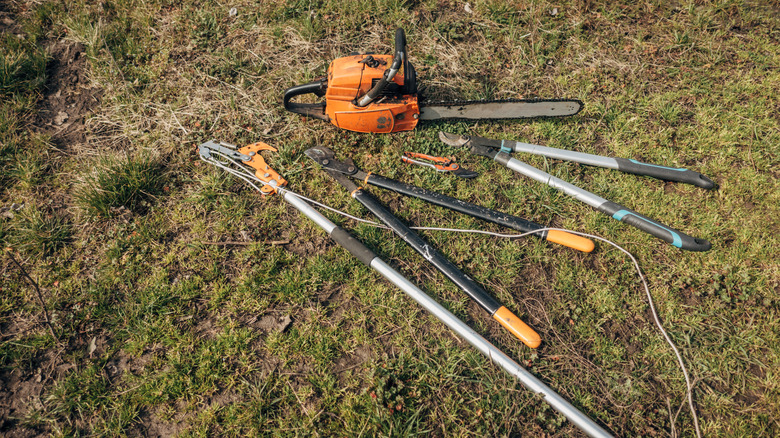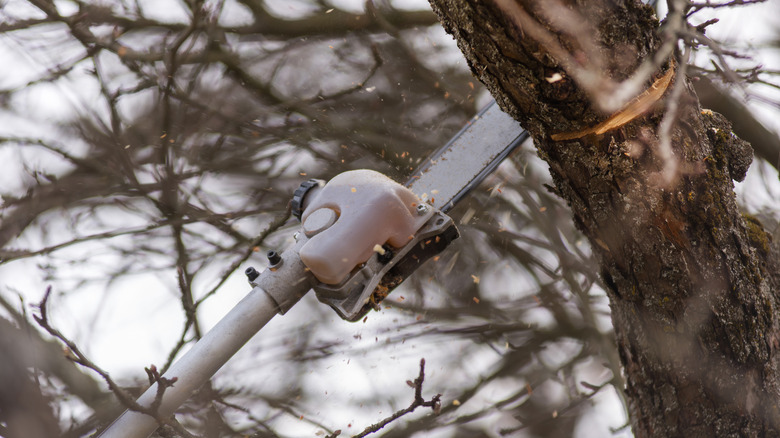
Peter Kniez/Shutterstock
By Joe Brown/
Chainsaws and pole saws both operate in similar ways, yet their uses are fundamentally different. If you’re new to the world of power tools, you may be wondering which tool is the right pick for the job at hand. In this comparison guide, we’ll be uncovering the key differences between each saw type, when you might use one, and the benefits you can gain from each type. All information in this article is provided by experts in the field (a detailed description of our methodology can be found at the end of this article).
Makita is one of the leading brands in the power tools industry, operating 123 service bases in its home country of Japan. Since its first cordless drill in 1978, it has become one of the largest manufacturers of cordless power tools across the world, selling products in 170 countries. One of the company’s groundbreaking developments was LXT (Lithium-Ion Xtreme Technology), first introduced in 2005, which was largely responsible for the transition from gas-powered to electric tools.
Although Makita does still offer some gas-powered chainsaws and pole saws, the majority of its saws utilize its innovative cordless technology. But which is the most appropriate for your work? Let’s explore what each type of saw has to offer so you can make a smart buying choice from the power tools giant.
What is a Makita Chainsaw?
Makita offers a wide range of high-quality electric chainsaws ideal for pruning, trimming, and yard maintenance. Its corded and cordless chainsaws are well known for their compact design and less noise than gas chainsaws, so you can work without disturbing the neighbors.
A notable advantage of electric chainsaws is they don’t require the manual oiling and mixing that gas ones require. They are also very eco-friendly. Many of Makita’s chainsaws feature its XGT technology, which has earned certification from the American Green Zone Alliance (AGZA) — a company that tests zero-emission products.
Makita’s chainsaws offer an array of features that make work a breeze for any hobbyist. Many offer varying speeds, ergonomic grips, and Makita’s own Extreme Protection Technology (XPT) for increased durability. There are several bar sizes available, such as 14″ bar chainsaws (suitable for small tree limb cutting and property maintenance) and 16–20″ bar sizes (for cutting bigger branches and small trees).
One great example is the Makita XCU11SM1 18V Brushless 14″ Chainsaw. Built with Makita’s fast-charging LXT lithium-ion battery, the chainsaw offers top-of-the-range power efficiency capable of managing most small to medium-duty tasks, such as cutting firewood and pruning.
What is a Makita Pole Saw?
While chainsaws can be used for medium to heavy-duty tasks beneath shoulder height, they aren’t very good for cutting high branches. Pole saws offer a more convenient way to cut limbs that are out of reach safely. Typically designed as a pruning saw attached to an extendable pole, pole saws reduce the risk of using a ladder and protect you from kickbacks while in operation.
Pole saws are available in both gas and electric models. Similar to chainsaws, gas-powered models are best for heavy-duty, longer projects, while electric pole saws are made for convenient, everyday use. Specializing in cordless technology, Makita mostly offers electric pole saws as a lightweight and quiet option for pruning high tree limbs.
Defying expectations of lower power from electric pole saws, Makita promises performance levels that are on par with gas-powered models. A great example is the GAU02M1 40V Cordless Pole Saw, which offers the power of a 35cc gas pole saw thanks to its brushless motor. The pole saw is equipped with a branch hook for removing loose branches while pruning for a safer work area.
Which saw is best for your needs?

Nes/Getty Images
Chainsaws are strongly recommended for heavy-duty tasks. Whether you’re cutting down trees or breaking down thick logs, a chainsaw has the power and endurance to get you through demanding tasks fast. Their great versatility means they can also be used for yard work, such as trimming small trees and bushes.
However, if your work involves trimming anything above shoulder height, pole saws offer the safest, most convenient option. One of the biggest dangers of using a chainsaw with a ladder is balance — it only takes a minor slip to lose control of the chainsaw. Many of Makita’s pole saws, like the GAU02M1, offer safety technology features such as Active Feedback-Sensing Technology (AFT), which automatically stops the motor if the saw’s speed stops abruptly.
Pole saws offer less power than chainsaws to reflect their intended use. If you’re looking for more power, explore gas-powered options first before attempting to use a chainsaw unsafely. Each saw is also designed at a suitable weight for its purpose. You don’t want to be using anything heavy when reaching up to great heights. For cutting through large amounts of wood fast, opt for a chainsaw. For delicate work, such as precisely removing tree branches, a pole saw is the best tool to use.
Methodology

Salajean/Getty Images
In our comparison of saw types, we’ve gathered information from chainsaw and wood experts who have spent years testing and reviewing products. Technical information on products has been provided directly from Makita, so you know exactly what each type of saw offers if you’re considering buying one. If you’re looking for useful power tools for renovation work, check out our list of popular Makita power tools for DIY jobs.